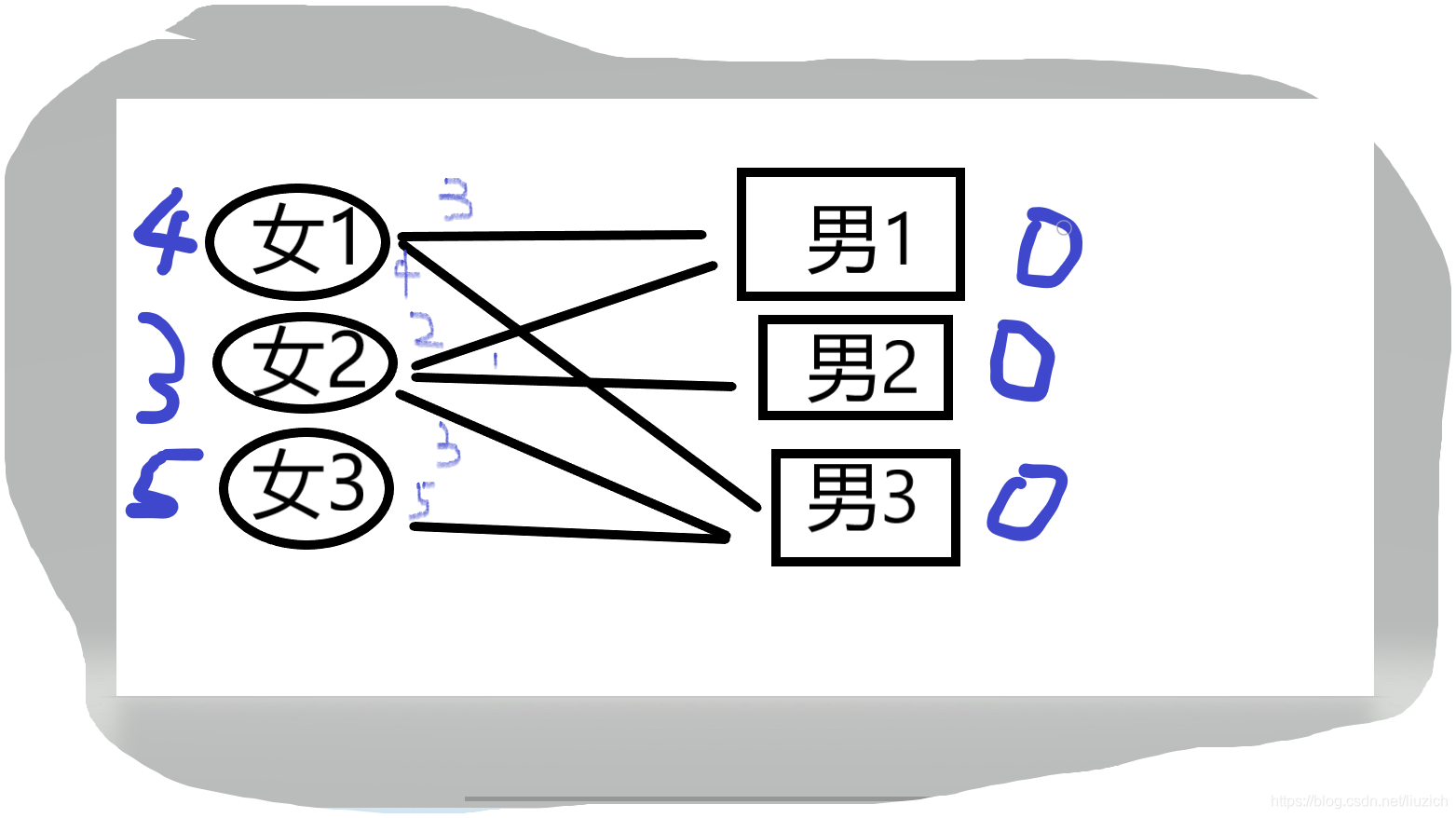假设有3个女的要嫁给三个男的,各有各的期望值。
如何让期望值之和最大?
此时我们就要用到传说中的km算法了。
这个算法本质上是贪心算法,怎么算呢?
举个例子吧

首先看女1,女1与男1间的边权值+男1期望值=3,而3不等于女一的期望值,所以配对失败。接着女1与男3间的边权值+男3的期望值=4,刚好4与女1的期望值相等,配对成功!

接着让女2找对象,匹配的过程就省略了,最后发现跟男3可以配对,而男3被女1占了,女2对女1说:“你能不能降低一下期望值啊?”于是女1同意了,但是我们还是得让女1跟男3可以配对,于是就将女1的期望值降低1,男3的期望值上升1,这样他们还是能够配对(男3挑剔了起来)。但是这样女2又不能配对了,就将女2的期望值也降低。这是发现女1可以和男1配对,就将他们配起来。

接着帮女3找对象,发现女3无法跟任何人配对,就只好将她的期望值降1,让她可以和男3配对。

此时女3发现男3被女2占了,于是就勒索让女2降低期望值,于是女2降低1期望值,为了以后还能找男3,所以男3的期望值上升1,女3期望值也得随之降1。这时女1的期望值也得降低1,因为女1也要保持随时可以与男3配对。 接着女2找上了男2,于是就跟男2配对。
此时三男三女都有了自己的对象了。(好开心,终于打完字了)
你以为这就结束了?
不可能 ,还有例题呢:
Description
小W在八中开了一个兼职中心。现在他手下有N个工人。每个工人有N个工作可以选择,于是每个人做每个工作的效率是不一样的。做为CEO的小W的任务就是给每个人分配一个工作,保证所有人效率之和是最大的。N<=200
Input
第一行给出数字N
接下来N行N列,代表每个人工作的效率。
Output
一个数字,代表最大效率之和
Sample Input
4
62 41 86 94
73 58 11 12
69 93 89 88
81 40 69 13
Sample Output
329
HINT
这就是km算法的模板题(虽然跟我举的例子有点出入,但本质上还是相同的)。
代码有点长,慢慢看啊
版本1:
#include<bits/stdc++.h>
using namespace std;
const int N=205;
int w[N][N];
int la[N],lb[N];
bool va[N],vb[N];
int match[N];
int delta,n;
void read() {
scanf("%d",&n);
for(int i=1;i<=n;i++)
for(int j=1;j<=n;j++)
scanf("%d",&w[i][j]);
}
bool dfs(int x) {
va[x]=1;
for(int y=1;y<=n;y++)
if(!vb[y])
if(la[x]+lb[y]-w[x][y]==0) {
vb[y]=1;
if(!match[y]||dfs(match[y])) {
match[y]=x;
return true;
}
}
else
delta=min(delta,la[x]+lb[y]-w[x][y]);
return false;
}
int KM() {
for(int i=1;i<=n;i++) {
la[i]=-(1<<30);
lb[i]=0;
for(int j=1;j<=n;j++)
la[i]=max(la[i],w[i][j]);
}
for(int i=1;i<=n;i++)
while(true) {
memset(va,0,sizeof(va));
memset(vb,0,sizeof(vb));
delta=1<<30;
if(dfs(i))
break;
for(int j=1;j<=n;j++) {
if(va[j])
la[j]-=delta;
if(vb[j])
lb[j]+=delta;
}
}
int ans=0;
for(int i=1;i<=n;i++)
ans+=w[match[i]][i];
return ans;
}
void write() {
printf("%d\n",KM());
}
int main() {
read();
write();
}
版本2:
#include <bits/stdc++.h>
using namespace std;
int n;
int w[305][305];
int lx[305],ly[305];
int matched[305];
int slack[305];
bool s[305],t[305];
bool match(int i) {
s[i]=1;
for(int j=1; j<=n; j++) {
int cnt=lx[i]+ly[j]-w[i][j];
if(cnt==0&&!t[j]) {
t[j]=1;
if(!matched[j]||match(matched[j])) {
matched[j]=i;
return 1;
}
} else {
slack[j]=min(slack[j],cnt);
}
}
return 0;
}
void update() {
int a=0x3f3f3f3f;
for(int i=1; i<=n; i++) {
if(!t[i])
a=min(a,slack[i]);
}
for(int i=1; i<=n; i++) {
if(s[i])lx[i]-=a;
if(t[i])ly[i]+=a;
}
}
void km() {
memset(matched,0,sizeof(matched));
memset(lx,0,sizeof(lx));
memset(ly,0,sizeof(ly));
for(int i=1; i<=n; i++) {
for(int j=1; j<=n; j++) {
lx[i]=max(lx[i],w[i][j]);
}
}
for(int i=1; i<=n; i++) {
memset(slack,0x3f,sizeof(slack));
while(1) {
memset(s,0,sizeof(s));
memset(t,0,sizeof(t));
if(match(i))
break;
else
update();
}
}
}
int main() {
scanf("%d",&n);
for(int i=1; i<=n; i++) {
for(int j=1; j<=n; j++) {
scanf("%d",&w[i][j]);
}
}
km();
int ans=0;
for(int i=1; i<=n; i++) {
ans+=lx[i];
ans+=ly[i];
}
printf("%d\n",ans);
return 0;
}
如果有什么地方没讲好或者是说讲错了,可以在评论区告诉我,我会看到后立马修改。
如果觉得有什么想法也可以在评论区说。
感谢观看。





















 203
203











 被折叠的 条评论
为什么被折叠?
被折叠的 条评论
为什么被折叠?








